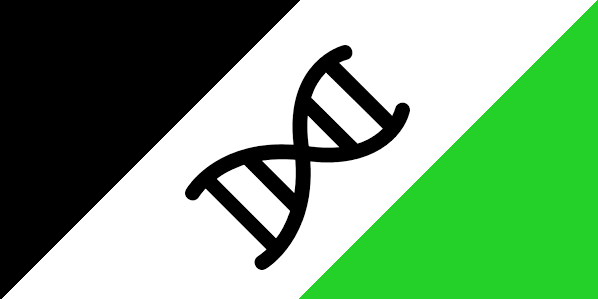BY LETTER
Gengineer Republic
Flag of the Gengineer Republic |
 Image from MacGregor |
Rise to Power
The Gengineer Republic's origins extend back to the early GeneTEK outposts around Jupiter in the late second century AT. Far from the regulations imposed by inner system powers, GeneTEK biotech research developed rapidly alongside increasingly profitable He3 mining. As such, the nascent Genetekker culture flourished in the Jupiter system and spread to the outer planets. While the Jovian League predominated on the Galilean moons, an assortment of Genetekker groups, the most prominent being the Tweak Co-Prosperity Advancement Front, came together and founded the Gengineer Republic on Horvat Station near Himalia in 292 AT. Vida Furlan was selected as the Governing Committee's first Archdesigner. Despite its name, initially the Gengineer Republic was more of an advocacy organization than a nation. It pressed for more progressive biotech research and autonomy from the GeneTEK corporate office. Tweaks, and to a lesser extent Superbrights and Provolves, flocked to their banner, and pro-Gengineer Republic sentiment became widespread throughout the Jovian League during the 300s AT. Eventually, under the charismatic leadership of Rupa Zan-Matsushita and Jenifer Nagarkar, the Gengineer Republic completed its subversion of the Jovian League, and absorbed its last remnants by 396 AT. After tense negotiations, the two leaders orchestrated the purchase of of all remaining GeneTEK assets in the Jovian system in 398 AT, granting them full independence. To mark the occasion, the Governing Committee constructed a new capital in orbit around Callisto.
The Lion of the Outer Planets
The Gengineer Republic, with a booming He3 mining industry and the most advanced biotech, quickly found itself the single greatest power in the Solar System. Its economic clout was further supplemented by advanced spaceship manufacturing and the export of software and cultural products. However, it could still not match the collective weight of the more developed inner system. It soon found itself in a long cold war with the Inner Council, especially the Cislunar Alliance. While visionaries such as Dr. Nadya Everett helped spread the Gengineer Republic's influence to other locations in the outer planets, it rarely enjoyed predominance outside of Jupiter and its moons.
Gengineer Republic society was notable at the time for its enthusiastic embrace of pantropy. A vast majority of clades possessed gengineered gene pools that helped them thrive in the austere low-gravity high-radiation environment of many outer system worlds and habitats. These changes were initially fairly moderate. However as the centuries passed, the changes in genetic makeup became far more dramatic than those usually found in the inner system, often causing others to regard Gengineer Republic citizens as abnormalities or freaks. Many historians hold that this insatiable appetite or experimentation was the defining trait of the Republic.
While the Gengineer Republic stretched over four planets, dozens of moons, and thousands of habitats, the short lag time for communications and low delta-v needed for the fusion drives then in use around its Jovian heartland allowed a highly diverse but discernible culture to emerge. Translator technology, primitive by modern standards, facilitated mutual intelligibility of the myriad of Old Earth languages spoken within the Republic's borders. Nevertheless, a distinctive Jovian Creole based on Swahili and Malay with strong influences from Mandarin, English, and Arabic spread amongst the populace for everyday use. It is thought that most Gengineer Republic citizens were atheists or agnostics, but sizable numbers followed various religions. There were local denominations such as Genetekker Vehicle Buddhism, a Vajrayana Tantra that rejected the asceticism of orthodox Buddhism. The faith known as Jovism began in the fifth century around Io, but would not proliferate until after the Technocalypse.
Even in its heyday, the Gengineer Republic was riddled with factions. The two largest were the Genomorphers and the Mutationists. The Genomorphers believed in creating a genome-augmented humanity methodically. Over time, the Genomophers would further diversify into Fusionists, Atavists, and Twin Stream clades. The Mutationists were more radical, and favored wild experimentation and in subsequent centuries largely split into the True Stem and New Shoot factions. Another group of note was the Black Fire terrorist faction, which grew to become a serious problem for republic authorities after the assassination of Governing Committee members Xao-Ni Olsen and Hubert Lobachevski in 496 AT.
Trials
Perhaps the most unique aspects of Gengineer Republic culture was that of the "trial". Cultural enthusiasm for bioengineering and a healthy economy ensured a large budget for the field in Jovian space, however the Republic's low population compared to Earth, Luna and increasingly Mars threatened to see those economies race ahead in the biosciences. Some factions sought to address this directly with hatcheries of exowombs growing batches of children for communal rearing, but these heightened growth rates would take a long time to reap rewards.
The Republic's desire to become and remain the system's premier polity in all forms of bioscience saw a lessening of regulations and safety procedures regarding research and clinical trials. Briefly experimental germline engineering came into vogue, but pressure from groups without and within quickly crushed that avenue. Particularly after the Leda City incident in which 212 children died horrifically in their teens due an unforeseen effect of their low gravity modifications causing dysfunctional hypertrophy. Like with all science at the time the majority of research was in silico, the most promising computer models would be tested on collections of tissues grown in bioreactors and the data used to refine further computer testing. Many cycles of this practice could eventually produce a mod to be tested in animals, or even humans, as part of a clinical trial. The Republic shortened this lengthy process by allowing healthy adult volunteers to step up and test experimental modifications at stages far earlier than any other polity in the system. These participants would come to be known as "Betas", a name derived from the old software alpha/beta test terminology. They would take on the risk to health and life as a service to science and the rest of the Republic.
There were many more failures than there were successes, but overall Beta Trials gave Republic science an edge it desperately needed. Cultural memes of service and sacrifice blossomed, with some extreme advocates even holding Betas in the same regard as previous societies had their military veterans. To be a Beta was to be someone willing to risk almost everything so that others might enhance their lives in future with reliable, well tested mods. Many other factions in solsys were aghast at this practice of mass human experimentation, particularly given the large numbers of Betas who required full time care for the rest of their life owing to disastrous side effects developed during or after their Trials. However as this care was fully provided by the Republican government, and Republican citizens widely volunteered to assist Betas that needed help, widespread opposition never gained much traction. A visitor to a Republican habitat could easily find memorials, statues and other artwork celebrating Betas that had risked everything for the dream of life that could exist anywhere, in whatever form it desired.
Historians have argued over the effectiveness of the Trials versus other avenues that the Republic could have chosen. The death and chronic morbidity toll remains unknown to this day. The Republic's stringent records suffered rewrites during the infoplagues. Historical analysis estimate the number of Betas suffering as a result of a Trial to be in the tens of millions over the course of the nation's history. The data that such experiments resulted in did provide a critical edge for Republican research, allowing them to refine their in silico and in vitro models faster than the rest of the system. In addition the cultural sunk cost stabilized memes for Trials all the way up to the Technocalypse.
Collapse
The Gengineer Republic weathered the calamities of the Technocalypse better than the inner system polities. This led some at the time to speculate that it would swiftly become the Solar System's lone superpower. However, this optimistic future proved illusionary. The plagues, malware, and rogue protowars left the Republic terminally crippled. The destabilizing effects of the Interplanetary Dark Age, starting around 641 AT, sapped the Gengineer Republic of its remaining vitality. A particularly vicious swarm outbreak in the 680s, known as the Great Shedding, only furthered the nation's decline. Efforts to shore up the political situation were continually undermined by new actors such as the Trust Networks that encroached on the Jovian system. Moreover, with the utter collapse of the inner system powers, the Republic lost one of its principal reasons for existing- namely, providing diplomatic protection for cutting-edge, and by some definitions illegal, genetic experimentation. Over the 8th century, the Gengineer Republic withered away into increasing irrelevance. The Republic's last Archdesigner Gugulethu Q. Shafir dissolved the Governing Committee on Copernicus 23, 784 AT.
Legacy
Most of the Gengineer Republic's successor states that survived the Dark Age would join the First Federation. Genetekker decedents of the Gengineer Republic would eventually join others to form House Genen. In the Current Era, the Solsys Organization and Formhault Acquisition Society have preserved or reconstructed several Gengineer Republic sites.
 Image from Steve Bowers |
Related Articles
- Gene
- Gene Expression
- Genehacker
- Genematode
- Genemod Human Dating and Matching Services
- Genen, House Genen
- Genestick
- GeneTEK
- Genetekkers, The
- Genetic Independents
- Genetics - Text by M. Alan Kazlev
The study of heredity, genes, and the genome, both terragen and alien (this latter is sometimes called xenogenetics). Includes also the mapping of the genotype with the phenotype, simulation of past and future inheritance and evolutionary paths, and the basic theory behind gengineering. - Gengineer, Geneer (profession)
- Genome
- Genotype - Text by M. Alan Kazlev; additions by Stephen Inniss
Hereditary constitution of an individual; its genome (or equivalent, in artificial neumann-capable organisms or in xenobionts). Contrast with phenotype. - Genotypic Augmentation - Text by M. Alan Kazlev
Modification or augmentation that effects only the genotype of the gametes and descendants of an organism. Genotypic augmentation is biological or genetic modification or augmentation that effects only the genotype of the gametes and descendants of an organism. It does not alter the characteristics of the user, or of clones from the user's somatic cells, but it does modify that of all of the user's offspring. Contrast with phenotypic augmentation. - Jovian League
- Jupiter
- Solsys Geopolitics 2100 - 2500 CE (131 - 531 AT)
Appears in Topics
Development Notes
Text by M. Alan Kazlev
Rewrite by MacGregor and Rynn 2018
Initially published on 31 October 2001.
2024-09-10 by the Astronomer; changed Jovian Creole to be based on Swahili and Malay (instead of Esperanto) as per TSSL's suggestion.
Rewrite by MacGregor and Rynn 2018
Initially published on 31 October 2001.
2024-09-10 by the Astronomer; changed Jovian Creole to be based on Swahili and Malay (instead of Esperanto) as per TSSL's suggestion.






